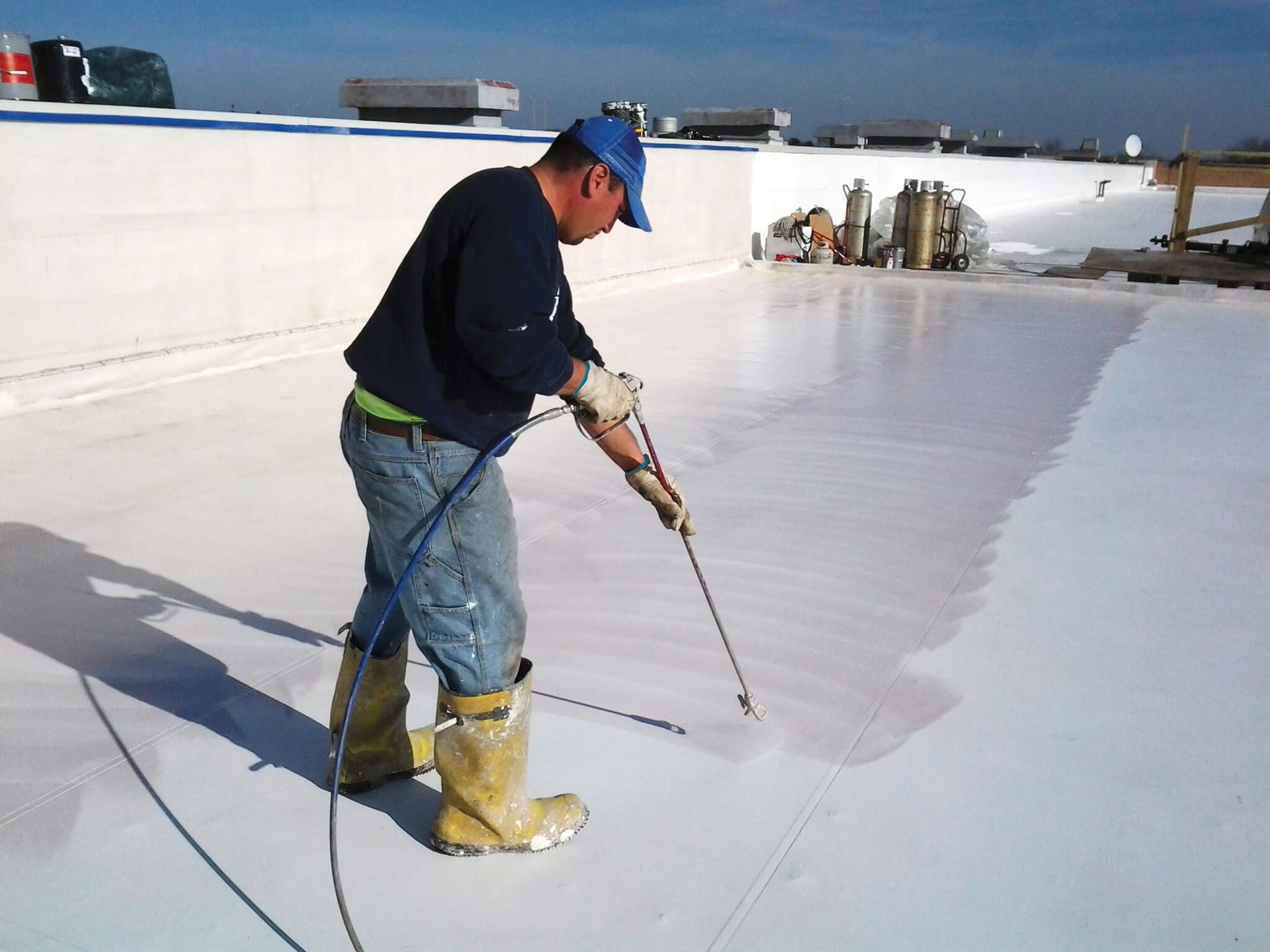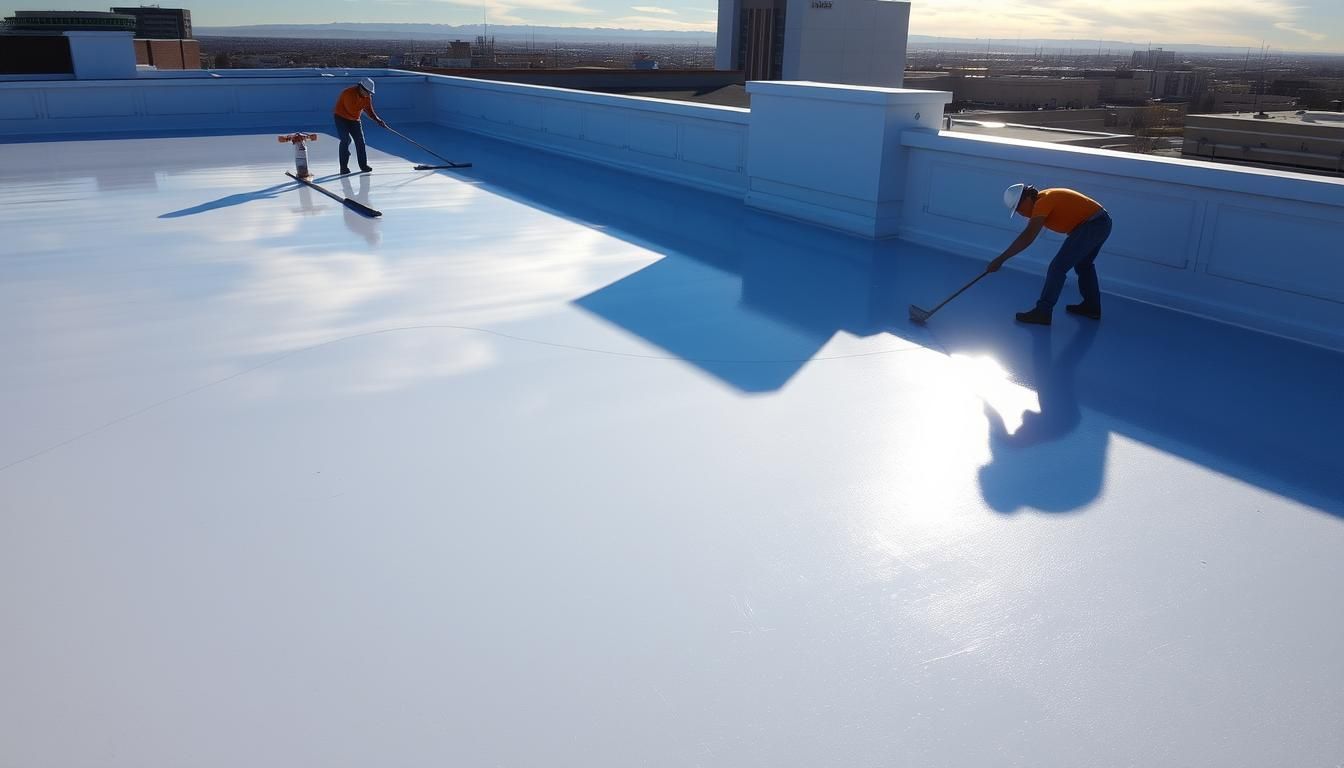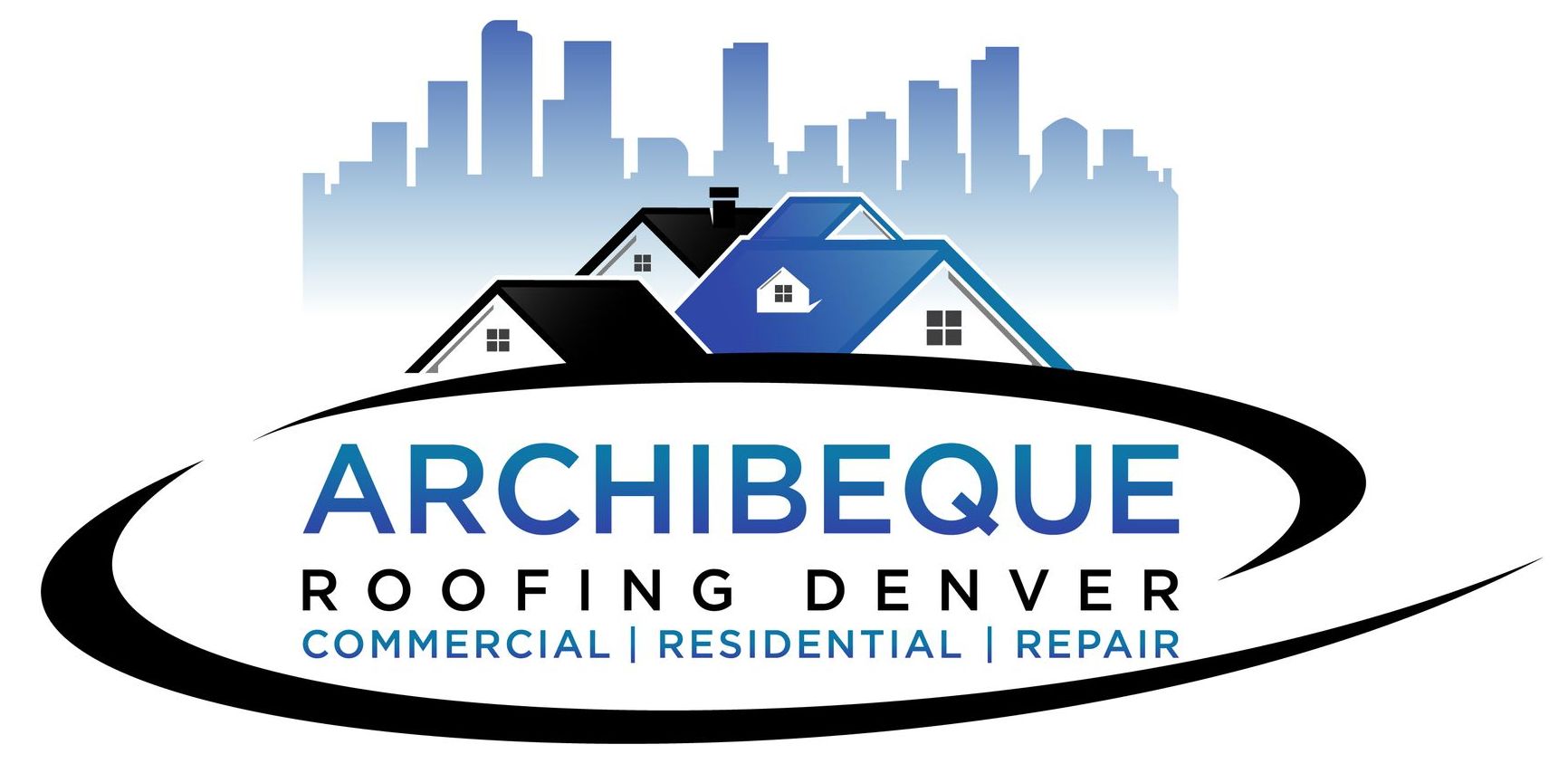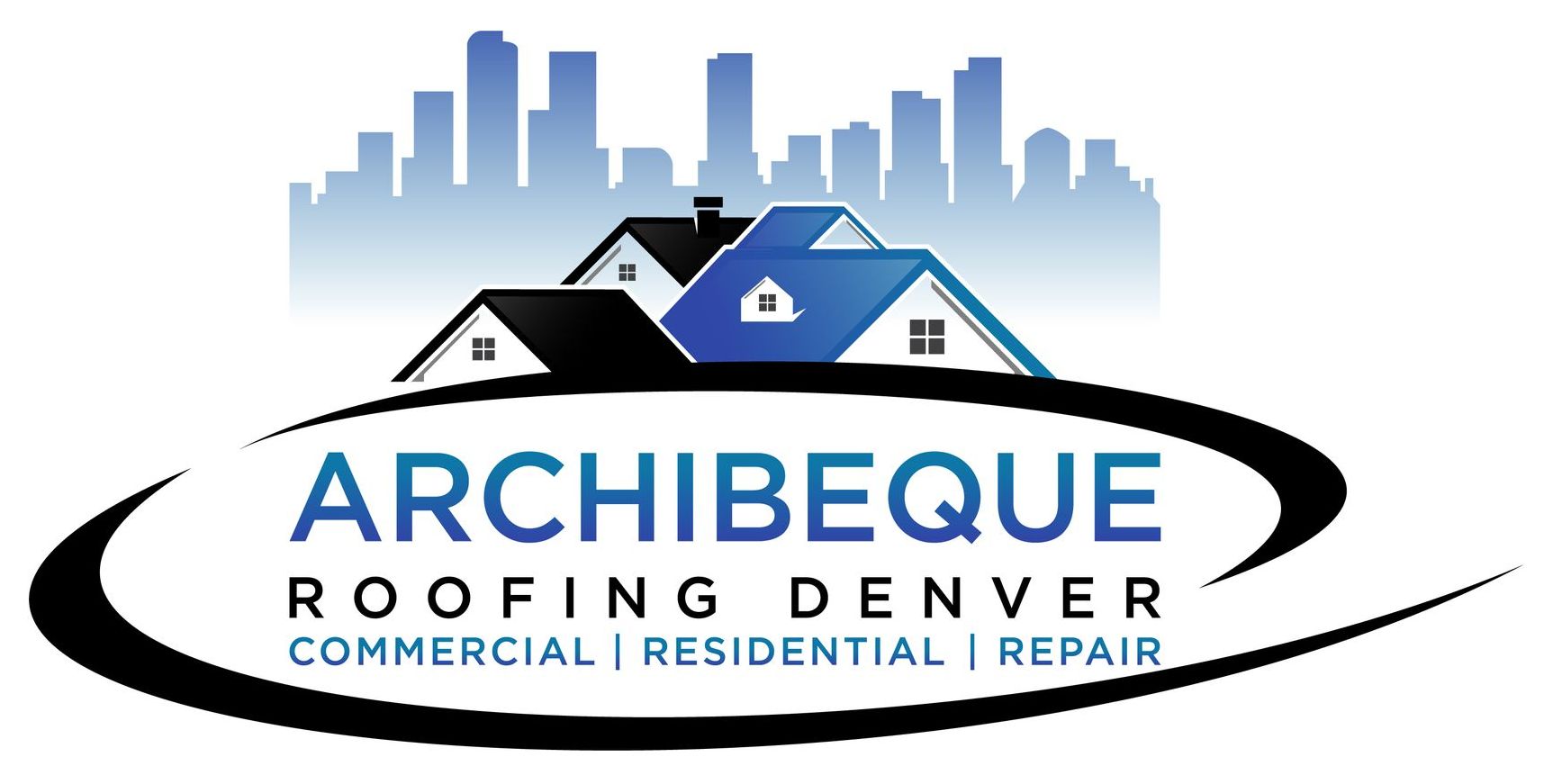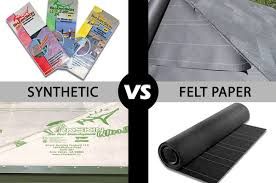
Regarding roof underlayment, roofers have three choices: tar paper, roofing felt, and synthetic roof underlayment. Each type of roof underlayment has its own set of unique advantages and is suited for different types of roof applications. Understanding the properties and benefits of each roof underlayment will help in making an informed decision that ensures the longevity and performance of the roofing system.
Tar Paper, a traditional form of roof underlayment, is a reliable moisture barrier made from paper or felt saturated with tar. Tar Paper and Its affordability and ease of roof installation make it a popular choice for many roofing projects, allowing you to be economically savvy. However, it is heavierand less durable compared to modern alternatives. It can also tear easily, particularly when exposed to harsh weather conditions over extended periods. Roofing Felt, another commonly used material, is quite similar to Tar Paper but is typically saturated with asphalt rather than tar.
This type of roof underlayment offers better durability and water resistance than Tar Paper, providing a reassuring investment. Roofing Felt comes in various thicknesses, typically measured in pounds per square (e.g., 15-pound or 30-pound felt), allowing roofers to select the right thickness based on the roofing requirements of the roofing project. Despite its enhanced durability compared to Tar Paper, Roofing Felt can still be susceptible to tearing and degradation when exposed to extreme weather.
Synthetic roof underlayment represents the latest advancement in roofing technology and has been gaining popularity due to its superior characteristics. Composed of polypropylene or polyethylene, Synthetic roof underlayment offers exceptional strength, lightweight properties, and enhanced resistance to moisture and UV rays. Unlike Tar Paper and Roofing Felt, Synthetic materials are far less likely to tear and can endure harsh weather conditions much better. Additionally, Synthetic roof underlayment often comes with non-slip surfaces, providing a safer working environment for roofers during installation.
When it comes to choosing between Tar Paper, Roofing Felt, and Synthetic roof underlayment, there are several factors to consider. These include budget, weather conditions, and specific roof project requirements. While Tar Paper and Roofing Felt have been longstanding options in the roofing industry, Synthetic materials are popular and increasingly becoming the preferred choice due to their durability, ease of installation, and superior performance characteristics. Regardless of the type of roof underlayment chosen, ensuring high-quality roof underlayment is crucial for protecting any roofing material longevity.
What Goes Under Shingles
When it comes to roofing, understanding what goes under shingles is crucial for ensuring a durable and weather-resistant roof. Professional roofers typically install an underlayment beneath the shingles to provide additional protection. This underlayment can be made from materials such as tar paper or felt. Tar paper, often felt, has been a traditional roofer’s choice for decades due to its reliability and affordability.
The felt underlayment serves multiple purposes: it acts as a moisture barrier, preventing water from seeping through to the roof's wooden structure, and importantly, it helps insulate the building, providing a comfortable and protected environment. Roofers can significantly extend the shingles' lifespan and the roofing system's overall integrity using quality underlayment materials like tar paper or felt. A properly installed underlayment ensures the roof is adequately prepared to withstand various weather conditions, making it an essential component in any roofing project.
Underlayment for Shingles on a Roof
The underlayment for shingles on a roof is a critical roofing component that ensures the longevity and durability of the roofing system. This protective layer, commonly made from tar paper or felt materials, is a barrier against moisture, the tar, or felt paper underlayment keeps the water from getting through and seeping into the roof deck and causing severe water damage. The roof shingle underlayment is installed directly onto the roof decking before the roof shingles are installed, providing an added layer of protection.
Tar paper, also known as asphalt-saturated felt, is one of the most traditional and widely used types of underlayment. It offers effective waterproofing properties and enhances the overall performance of the roof. Another popular option is synthetic underlayment, which offers superior tear resistance and durability compared to traditional felt. Proper underlayment installation ensures that the shingles perform optimally and the roof remains watertight.
However, it's important to note that the job doesn't end there. Regular roof maintenance and inspection of the underlayment are crucial. The shingle underlayment will help identify potential roofing problems before they escalate, thereby extending the lifespan of the shingles and the entire roof system.
Rubberized asphalt underlayment stands out due to its unique qualities that offer robust protection and flexibility for any roofing project. Here's a breakdown of its key distinguishing features:
Exceptional Durability
Unlike other types of underlayment, rubberized asphalt is renowned for its exceptional durability. It offers superior resistance to tears, punctures, and adverse weather conditions. This makes it a reliable choice for safeguarding your roof through harsh winters and scorching summers, ensuring long-lasting protection.
Superior Waterproofing
One of the standout features of rubberized asphalt underlayment is its waterproofing capabilities. It creates a watertight seal, providing an effective barrier against moisture penetration. This is particularly beneficial in preventing leaks and protecting the underlying structure, especially in areas prone to heavy rain or snow.
Self-Adhesive Properties
Rubberized asphalt often comes with self-adhesive backing, simplifying installation. This feature not only speeds up the process but also enhances the bond between the underlayment and the roof deck. By ensuring a snug fit, it minimizes the risk of water seeping underneath the roofing material, offering peace of mind over time.
Flexibility and Adaptability
This type of underlayment is highly flexible, adapting well to roof contours. This flexibility helps it to maintain its integrity despite structural movement or temperature fluctuations. It also means easier handling and installation, reducing the likelihood of installation errors and ensuring a perfect fit.
Resistance to UV Damage
Rubberized asphalt underlayment often includes resistance to UV radiation. This prolongs its life span, making it ideal for applications where the final roofing cover might be delayed. Prolonged UV exposure can degrade other materials, but rubberized asphalt maintains its effectiveness and strength.
Conclusion
In essence, rubberized asphalt underlayment distinguishes itself with its durability, superior waterproofing, ease of installation, flexibility, and UV resistance. These characteristics make it a premium choice for homeowners and roofing professionals aiming to achieve a robust and reliable roofing system
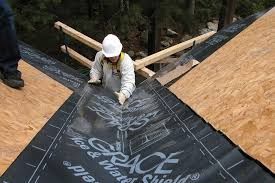
Roofing shingle underlayment, a critical component in the construction and longevity of any roofing system, tar paper and felt underlayment should be installed directly onto the roof deck before the roof shingles. Its is a necessary step when replacing or repairing shingles on a new roof is to provide an additional barrier against water infiltration, safeguarding the roof structure from potential water damage. Tar paper, traditionally used for this purpose, is known for its durability and effectiveness in preventing moisture penetration. Felt, another popular choice for underlayment, offers similar benefits with added flexibility and ease of installation.
Together, these materials ensure that the roof remains resilient in harsh weather conditions. More importantly, they play a significant role in prolonging the life of the shingles, thereby maintaining the integrity of the entire roofing system. Proper tar paper and roof felt underlayment before installation of roof shingles, metal, synthetic cedar shake roofing materials are essential to achieving a durable and reliable roof that can withstand environmental challenges.
Shingle Underlayment
Roof shingle underlayment, a critical component in the construction and longevity of any roofing system, tar paper and felt underlayment should be installed directly onto the roof deck before the roof shingles. Its is a necessary step when replacing or repairing shingles on a new roof is to provide an additional barrier against water infiltration, safeguarding the roof structure from potential water damage. Tar paper, traditionally used for this purpose, is known for its durability and effectiveness in preventing moisture penetration. Felt, another popular choice for underlayment, offers similar benefits with added flexibility and ease of installation.
Together, these materials ensure that the roof remains resilient in harsh weather conditions. More importantly, they play a significant role in prolonging the life of the shingles, thereby maintaining the integrity of the entire roofing system. Proper tar paper and roof felt underlayment before installation of roof shingles, metal, synthetic cedar shake roofing materials are essential to achieving a durable and reliable roof that can withstand environmental challenges.
Felt Underlayment
Felt underlayment, referred to as tar paper or black paper, is a crucial component in the roofing industry. This material serves as a protective layer between the roofing deck and the shingles, providing additional security against water infiltration and other weather-related damage. Made from a combination of asphalt and natural or synthetic fibers, felt underlayment is both durable and flexible.
Its primary advantage is its ability to act as a secondary moisture barrier, ensuring that even if the outer roofing layer is compromised, water does not easily penetrate the structure below. This emphasis on its durability instills a sense of security in homeowners and contractors about the longevity of their roofing system.
Aside from its protective qualities, felt underlayment also significantly contributes to the longevity of a roofing system.
Its extra layer of insulation helps regulate temperature and reduce energy costs. Moreover, it enhances the roof's structural integrity by adding an extra layer of strength. The process of installing felt underlayment, which involves laying down sheets of black paper over the entire roofing deck before the final roofing material is applied, is not only straightforward but also cost-effective. This makes it a popular choice among Denver homeowners and roofing contractors, highlighting its feasibility and value for money in roofing projects.
When evaluating the cost of roofing projects, it's crucial to consider the expense of felt underlayment. While it may increase the initial investment, its benefits in terms of durability and protection far exceed the costs. In comparison to other underlayment options, such as synthetic materials, felt underlayment remains a cost-effective choice without compromising quality. Therefore, incorporating felt underlayment is a vital step for those seeking long-lasting and dependable roofing solutions, offering a reassuring return on investment.
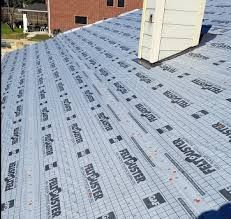
Roof shingle underlayment, as a secondary barrier against the elements, is a crucial component in constructing and maintaining a durable and weather-resistant roof. It is typically installed directly onto the roof deck before the shingles are applied. One of the most commonly used materials is tar paper, black paper, or felt. Tar paper, a heavy-duty paper impregnated with tar, creates a waterproof layer that adds extra protection to the roof structure. Using felt, another term for tar paper, ensures that any water penetrating the shingle layer is effectively diverted away from the roof deck, preventing leaks and potential water damage. Roof shingle underlayment, beyond its protective qualities, and works as a catalyst to the overall performance and longevity of the shingle roof.
Roof shingle underlayment also provides an additional layer of insulation, helping to regulate temperature fluctuations and reducing thermal stress on the shingles. This added insulation also contributes to energy efficiency by minimizing heat transfer through the roof. Furthermore, felt underlayment can improve the fire resistance of the roof, offering an extra safeguard in case of fire-related incidents. Choosing the right material for roof shingle underlayment is a critical decision. It directly impacts the long-term durability and effectiveness of the roof.
While traditional tar paper or black paper remains a popular choice due to its proven reliability, advancements in roofing technology have introduced synthetic underlayment that offer superior tear resistance and longer lifespans. Regardless of the chosen type, the responsibility of proper roof shingle underlayment installation is paramount. It must be laid out in overlapping layers, with particular attention paid to areas prone to water infiltration such as valleys and eaves. This proactive approach ensures that the underlayment performs its intended function, safeguarding the integrity of the roof against environmental challenges.
Roofing Tar Paper
Roofing tar paper, a vital underlayment in roof construction and maintenance, plays a key role in enhancing the longevity of shingles. It acts as a crucial barrier against moisture, available in various thicknesses, including 15 and 30 LB. The roll format of tar paper makes it easy to install across large surface areas. When properly installed, this tarred material acts as an effective underlayment, safeguarding the roof's structural integrity by preventing water infiltration.
The application process of roofing tar paper is a meticulous task that begins with unrolling the material across the roof deck. It's crucial to ensure that each roll overlaps sufficiently to create a continuous barrier. This tar paper overlapping technique is a best practice, particularly in areas prone to heavy rainfall or snow, and is critical to maintaining the effectiveness of the tar paper. The choice between 15 and 30 LB tar paper is not arbitrary, but rather depends on the specific needs of the project; 15 LB tar paper is lighter and easier to handle, while 30 LB offers increased durability and resistance to tearing.
When considering a new roof installation or a roof repair, the type of tar paper used can significantly impact the roofing system's overall performance. High-quality tarred paper, a robust underlayment, not only supports the shingles but also acts as a secondary line of defense against leaks. This enhances the roof's ability to withstand harsh weather conditions, giving you confidence in the strength of your roofing system.
Consequently, investing in robust roofing tar paper can lead to fewer maintenance issues and prolong the shingles' lifespan and the roof itself. Roofing tar paper is indispensable to any roofing project. Whether opting for 15 or 30 LB rolls, this tarred material provides a critical layer of protection that ensures durability and resilience, ultimately safeguarding the roof and its underlying structures.
Tar Paper Roof
Tar paper roofs are a cost-effective and reliable solution for protecting structures from the elements. These roofs' primary components include tarpaper, also known as roofing felt. Tarpaper is typically impregnated with tar to enhance its water-resistant properties. It comes in various weights, commonly 15 lb and 30 lb, indicating the weight of the material per 100 square feet. When installing a tar paper roof, one can choose between different forms: shingle or roll. Shingles are small, individual pieces of tar paper, whereas rolls provide a continuous sheet, making the installation process quicker and often more seamless.
Applying a tar paper roof begins with laying down either a 15-lb or 30-lb base layer. For those seeking robust protection, the 30-lb tarpaper, with its enhanced durability, provides a secure and confident choice. Once the tarpaper is in place, it can be secured with additional roofing materials such as shingles. Shingle installations involve overlapping pieces to create an extra barrier against moisture infiltration. Using a roll of tar paper allows for fewer seams and potentially reduces the likelihood of leaks, further enhancing the security of your choice.
Historically, tar paper roofs have been favored for their simplicity and affordability. A well-installed tarred roof can provide many years of service with minimal maintenance, making the audience feel at ease and comfortable with their choice. Whether opting for shingle or roll formats, the choice between 15 lb and 30 lb tar paper is crucial in determining the longevity and effectiveness of the roof. In conclusion, selecting the appropriate type and weight of tar paper is essential for ensuring a durable and efficient roofing solution that matches various weather conditions.
15 lb. Tar Paper
15 lb. tar paper is a versatile and essential product in the construction and roofing industry. A roll of 15 lb. tar paper typically serves as an underlayment that provides a membrane like durable, water-resistant layer between the roof deck and the final roofing materials. This tarpaper is known for its impressive quality and reliability, ensuring the roof remains protected from moisture and other elements. Available in both 15 lb and 30 lb variations, the 15 lb. tar paper is often preferred for its balance of strength and ease of handling. Each roll of this tarred material is designed to cover a substantial area, making it a cost-effective solution for large roofing projects, allowing you to be prudent with your resources.
When it comes to selecting tar paper, quality is paramount, and the 15 lb. variant delivers. It is manufactured to withstand harsh environmental conditions, extending the roofing system's lifespan. Contractors and builders frequently choose this type of tar paper due to its proven performance and ease of installation, instilling confidence in the durability of their projects. Unlike its 30 lb. counterpart, the 15 lb. tar paper is lighter, which can be advantageous when maneuvering rolls during application. Despite its lighter weight, it still offers robust protection against water infiltration and contributes significantly to the overall integrity of the roofing structure.
The 15 lb. tar paper is available in convenient rolls, making transportation and storage on job sites a breeze. This user-friendly feature, coupled with its high-quality materials, makes it a go-to choice for residential and commercial roofing in Denver. Whether you're working on a new build or a renovation, the ease of the 15 lb tar paper use and reliable protection of a quality roll of 15 lb. tarred paper ensures your Denver commercial and residential roof is well-protected against the Denver weather elements, heavy snow, hail, storm damage and freezing temperatures the 15 lb tar paper will be safeguarding your investment for years to come.
30 lb. Tar Paper
15 lb. tar paper is a versatile and essential product in the construction and roofing industry. A roll of 15 lb. tar paper typically serves as an underlayment that provides a strong but durable, water-resistant layer between the roof deck and the final roofing materials. This tarpaper is known for its impressive quality and reliability, ensuring the roof remains protected from moisture and other elements. Available in both 15 lb and 30 lb variations, the 15 lb. tar paper is often preferred for its balance of strength and ease of handling. Each roll of this tarred material is designed to cover a substantial area, making it a cost-effective solution for large roofing projects, allowing you to be prudent with your resources. Its cost-effectiveness is further enhanced by its durability,in any weather reducing the need for frequent replacements and maintenance.
When it comes to selecting tar paper, quality is paramount, and the 15 lb. variant delivers. It is manufactured to withstand harsh environmental conditions, extending the roofing system's lifespan. Contractors and builders frequently choose this type of tar paper due to its proven performance and ease of installation, instilling confidence in the durability of their projects. The 15 lb. tar paper, in particular, is designed for easy and quick installation, reducing labor costs and project timelines. Unlike its 30 lb. counterpart, the 15 lb. tar paper is lighter, which can be advantageous when maneuvering rolls during application. Despite its lighter weight, it still offers robust protection against water infiltration and contributes significantly to the overall integrity of the roofing structure.
Moreover, the 15 lb. tar paper is available in convenient rolls, making transportation and storage on job sites a breeze. This user-friendly feature, coupled with its high-quality materials, makes it a go-to choice for residential and commercial construction projects. Whether you're working on a Denver home, new build or a commercial renovation, the ease of use and reliable protection of a quality roll of 15 lb. tarred paper ensures your roofing system is well-protected against the elements, safeguarding your investment for years to come.
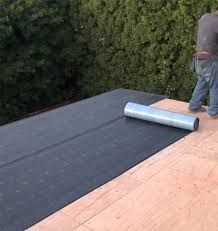
Tarpaper, often called tar paper, is a widely utilized roofing underlayment known for its waterproofing properties. Typically sold in tar paper rolls, it is an essential underlayment in roofing and exterior wall applications. The tarpaper is usually made by impregnating paper or fiberglass mat with tar, thus making it both durable and flexible. There are various grades of tar paper available, commonly classified by weight.
The choice of the right grade, such as 15 lb or 30 lb, is crucial as it determines the suitability of the tar paper for different roof construction projects. The 15 lb tar paper is lighter and easier to handle, making it suitable for residential projects. Conversely, the 30 lb tarpaper offers enhanced durability and water resistance, making it ideal for commercial applications or areas exposed to harsh weather conditions.
The adaptability of tar paper to different roof replacement and repair requirements is a testament to tarpapers versatility. The quality of tar paper is paramount to its performance. High-quality tar paper rolls ensure longevity and reliability, safeguarding structures from moisture ingress. Additionally, the tarred coating on the paper plays a critical role in its effectiveness, providing a robust barrier against water penetration.
When selecting tar paper, roofing contractors often weigh the benefits of 15 lb versus 30 lb tar paper based on the specific requirements of their projects. While 15 lb tarred paper might be sufficient for milder climates, the 30 lb variant provides added peace of mind in more challenging environments like Denver, CO.
Tarpaper remains an indispensable residential & commercial roof underlayment in remodeling and new roof and wall construction due to its versatility and protective water resistant qualities. Whether opting for a 15-lb or 30-lb tar paper roll, ensuring high quality is crucial for optimal performance.
The choice between different weights and qualities allows builders to tailor their selections to meet the unique demands of each project, thereby ensuring structural integrity and long-term protection against the elements. This emphasis on protection should reassure you about the safety of your structures.
Roof Tar Paper
Roof tar paper, or rollfelt, is a must-have in both residential and commercial roofing systems. This material acts as a critical underlayment beneath shingles, providing additional protection against moisture infiltration. By acting as a barrier, tar paper ensures that the roof structure remains dry and free from leaks, preventing costly repairs and structural damage. Available in rolls, this underlayment can be easily applied across the entire roof surface before shingle installation. The durability and water-resistant properties of roof tar paper make it a preferred choice for many contractors and homeowners, offering a cost-effective roofing water tight solution that significantly extends the lifespan of the roofing system, maintaining its integrity and enhancing its overall performance.
Roll of Tar Paper
A roll of tar paper underlayment is not just a barrier, it's a key player in enhancing the overall performance of residential and commercial roofs. It creates a watertight barrier between the roofing deck and the primary roofing materials, providing crucial protection across various climates and conditions. By preventing water infiltration and extending the lifespan of shingles, metal, cedar shake, clay, synthetic slate, and other roofing materials, it ensures added durability and resistance against environmental elements. T
The tar paper roll is easy for roofers to work with and is particularly valued for its cost-effectiveness, offering a relatively inexpensive way to enhance the roof's overall performance. Moreover, the installation of a roll of tarred paper underlayment is a straightforward process, instilling confidence in homeowners and contractors. It seamlessly integrates into new roofing projects or re-roofing endeavors, serving as the first line of defense against moisture damage. This underlayment also aids in temperature regulation, contributing to energy efficiency and cost reduction.
From a financial perspective, investing in a roll of tarred paper underlayment is a prudent decision. The initial cost is relatively low, especially when compared to the long-term savings from extended roof life and reduced roof maintenance. Tar paper prevents water damage and other related roof problems, this roof underlayment helps maintain the structural integrity of the entire roof system, protecting the significant investment in shingles and other roofing materials. Remember a roll of tarred paper underlayment is crucial for a durable, efficient, and cost-effective roofing solution, providing a water resistant roof security for Denver homeowners and contractors.
Roofing Felt Paper
Roofing felt paper or felt or paper underlayment is a crucial investment in constructing and maintaining a durable roof. This material, typically made from a combination of asphalt and felt paper, acts as a protective layer between the roof decking and the roof shingles. Its primary job is to provide an additional layer of waterproofing, safeguarding the underlying wood roof deck from moisture damage, which can lead to costly repairs. By acting as a secondary barrier, roofing felt paper ensures that even if the shingles are compromised, water will not easily penetrate the interior framework of the building, providing a secure and long-lasting solution.
Applying felt or paper underlayment is not just about enhancing a roof's waterproofing capabilities and longevity. It's about ensuring the roof's integrity over time. When properly installed, this underlayment helps prevent mold growth and wood rot, which can significantly degrade the roof's integrity. Moreover, roofing felt paper contributes to the smooth installation of shingles by offering a flat, even surface. This results in better adhesion and alignment of shingles, ensuring that the roof performs optimally in various weather conditions, giving you peace of mind about the quality of your roof.
While the initial cost of installing roofing felt paper might seem like an added expense, it is an investment that pays off in the long run. The cost associated with this underlayment is relatively low compared to the potential expenses incurred from water damage or premature roof replacement. Therefore, incorporating felt or paper underlayment into your roofing system is not just a strategic move to enhance durability, but also a smart financial decision. In conclusion, roofing felt paper is indispensable in modern roofing practices, offering both practical benefits and cost-efficiency.
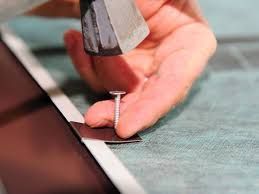
Roofing Felt Nails
Roofing felt nails play a crucial role in roof installation and roof longevity. These specialized nails are designed to secure roofing felt, an essential underlayment material that attaches to the roof deck. The underlayment, commonly known as roofing felt it provides a protective barrier that shields the roof from moisture and enhances its overall durability. Properly securing the felt with appropriate nails ensures the roof remains watertight and can effectively support the shingles above it. Using high-quality roofing felt nails prevents potential leaks and extends the roof's lifespan.
When it comes to the selection of roofing felt nails, it's not just about the quality and cost. It's about making a smart investment in the future of your roof. While cheaper options may seem appealing, investing in premium roofing felt nails can actually save you significant expenses in the long run. These high-quality nails provide a stronger hold, reducing the risk of the felt becoming loose or damaged over time. They are typically corrosion-resistant, enhancing their durability and performance.
By choosing the proper roofing felt nails, homeowners andr oofing contractors in Denver can ensure they have a more secure and long-lasting roof structure, proving that quality is not always expensive, but it's always cost-effective.
When it comes to Denver roof repair and installation, it's not just about the materials you use. It's about the practices you follow.
Following best practices when using roofing felt nails is essential. Ensuring that each nail is driven in at the correct angle and depth is vital for maintaining the integrity of the underlayment and preventing damage to the shingles. Properly installed nails will help distribute weight evenly across the roof, minimizing stress points that could lead to premature wear or failure. By paying careful attention to detail during installation, homeowners and contractors can significantly impact the overall effectiveness and longevity of the roof system, proving that being responsible and proactive can make a world of difference.
Black Roofing Paper
Black roofing paper, an essential underlayment Denver roof contractors use, serves as a vital underlayment that provides several benefits. These shingles, metal, cedar shake, and tile roof underlayment material, often felt or tar paper, are installed directly onto the roof deck before being applied to the shingles. The primary purpose of black roofing paper is to act as a protective barrier against moisture and weather elements. This not only prevents water from seeping into the underlying wood structure, which could lead to rot and other costly damages, but also extends the roof's lifespan, ensuring a secure and long-lasting investment for homeowners and contractors.
When considering installing or repairing a newer roof or replacing an existing roof, it's important to factor in the cost of black roofing paper. While the initial expense of this underlayment may seem like an additional cost, it's actually a smart investment that can save homeowners and contractors significant amounts of money in the long run. By providing an extra layer of protection, black roofing paper helps to ensure that the shingles perform effectively and maintain their integrity over time, reducing the need for costly repairs in the future.
Black roofing paper significantly enhances the overall durability and performance of the roofing system. It provides a stable surface for the shingles to adhere to, thereby reducing the risk of shifting or buckling. The black roofing papers stability is particularly crucial in areas prone to severe weather conditions such as heavy rains or strong winds. The underlayment acts as a secondary line of defense, offering homeowners and contractors a sense of security and peace of mind that their roof is well-protected.
The black roofing paper is a critical underlayment that plays a significant role in safeguarding roofs. Despite its associated cost, its benefits in terms of moisture protection, structural integrity, and overall longevity make it an indispensable element in modern roofing practices. Whether installing new shingles or replacing an old roof, incorporating black roofing paper is a prudent decision that can enhance the performance and durability of your roofing system.
Roofing Paper
Roofing paper, also known as underlayment, is essential to constructing and maintaining a roof. This material is typically installed directly onto the roof deck, beneath the shingles, providing additional protection against Denver weather elements such as rain, snow, and wind. The primary function of roofing paper is to act as a barrier that prevents water from infiltrating the roof structure, thereby safeguarding the integrity and longevity of the building. Even the most durable shingles might only offer adequate protection with proper underlayment, leading to potential damage and increased repair costs.
Roofing paper, a cost-effective measure, significantly enhances a roof's durability and performance. It acts as a secondary defense line if shingles are compromised or displaced due to severe weather conditions. More importantly, it prevents mold and mildew growth by acting as a moisture barrier, ensuring a healthy indoor environment. The relatively low cost of installing roofing paper is a smart investment compared to potential expenses associated with water damage repairs and structural issues caused by inadequate roofing protection.
Roofing paper, in addition to its protective qualities, facilitates easier shingle installation. It provides a smoother surface for shingles to adhere to, ensuring a more uniform and aesthetically pleasing finish. Furthermore, high-quality underlayment can extend the roof's life span by preventing premature wear and tear on shingles. Investing in roofing paper is a prudent decision for any property owner looking to enhance their roof's durability, performance, and overall cost-effectiveness.
Paper For Roofing
When considering roof underlayment materials for a roofing project, paper underlayment plays a pivotal role. This component, often referred to simply as roofing paper, is essential for ensuring the durability and longevity of a roof. Roofing paper acts as a protective barrier between the roof deck and the shingles, providing additional waterproofing that is a reliable shield against leaks and water damage. By making sure during a roof repair or replacement that the Denver roofers install paper underlayment on thier Denver roof homeowners can significantly enhance the performance & longevity their roofs. This will leave homeowners in Denver feeling secure even in areas prone to heavy snows and brutal hail storms that damage roofs and extreme freezing weather conditions.
The selection of high-quality roofing paper will also impact the cost of the residential roofing project. While opting for premium underlayment may increase initial expenses, it often results in long-term savings reducing maintenance costs and extending the roof's lifespan. This financial savvy decision allows homeowners to choose an option that best fits their budget without compromising quality. Integrating this underlayment with shingles ensures a more robust and resilient roofing system, making them feel smart about their investment.
In addition to its functional benefits, roofing paper contributes to the aesthetic appeal of a roof. A well-installed underlayment ensures that shingles lay flat and evenly, creating a visually pleasing finish that homeowners and contractors can take pride in. Moreover, proper installation of roofing paper can prevent common issues such as shingle warping or buckling, which not only detract from the roof's appearance but can also lead to costly repairs. Overall, investing in high-quality paper underlayment is a sound decision that balances initial cost considerations with long-term benefits, safeguarding the roof's structural integrity and visual appeal.
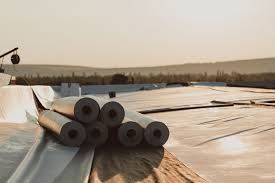
A roll of roofing paper, also known as underlayment, is a key player in the longevity and durability of a roof. This specialized roofing paper acts as a shield, protecting the roof deck and the shingles. Its primary job is to prevent water infiltration, particularly in severe weather conditions. By stopping moisture from penetrating the shingles and reaching the roof structure, roofing paper plays a crucial role in maintaining the building's integrity. Moreover, it provides a smooth and consistent surface for the shingles to adhere to, which is essential for achieving the best installation results.
The cost of roofing paper can vary based on the quality and material used. However, it's important to remember that investing in high-quality underlayment is often the best choice for homeowners and contractors. While it may increase the initial cost of roofing projects, the long-term benefits far outweigh the expense. Quality underlayment can extend the roof's life, reduce maintenance costs, and enhance overall performance. Additionally, premium roofing paper can improve energy efficiency by providing an extra insulation layer. When selecting roofing paper, it is crucial to consider weather factors such as climate, roof slope, and type of shingles being used.
Different environments and roofing materials may require specific types of underlayment to achieve optimal results. Consulting with a professional roofer can help determine the best underlayment for your needs, providing you with expert guidance and support. In summary, a roll of roofing paper is an indispensable component in modern roofing systems, offering protection, durability, and improved performance at a relatively low cost. Investing in high-quality underlayment ensures your roof remains robust and resilient for years.
Roofing Paper Roll
Roofing paper roll, often called roofing underlayment, is crucial in constructing and maintaining a durable roof. Typically made from asphalt-saturated felt or synthetic materials, this material is installed directly onto the roof deck before applying shingles. The primary function of the roofing paper roll is to provide an additional layer of protection against water infiltration, ensuring that the structure beneath remains dry and secure. The roofing paper works as a barrier and plays a vital role in preventing potential damages that could lead to costly repairs, making you feel secure and protected.
The use of roofing paper rolls is beneficial for water resistance and improves the overall stability of the roof. During installation, this underlayment helps to prevent the shingles from adhering directly to the roof deck, facilitating easier replacement and maintenance. Additionally, roofing paper aids in reducing the impact of wind uplift on roof shingles, thereby enhancing the roof's wind resistance. Given these significant advantages, investing in quality roofing paper rolls can be a cost-effective measure in the long run, making you feel financially savvy and secure in your investment.
When considering the cost implications, it is essential to recognize that while roofing paper roll may add to the initial expenditure, its benefits far outweigh this upfront cost. Preventing moisture penetration and providing an additional layer of insulation help maintain the thermal efficiency of the building. Not using the roofing paper roll can lead to reduced energy costs over time, making you feel environmentally conscious and responsible. Furthermore, using high-quality underlayment contributes to extending the lifespan of shingles, ensuring that they remain effective in protecting the roof against environmental elements.
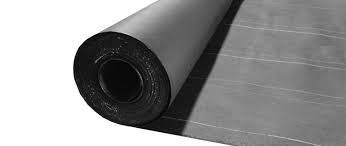
Felt paper, a crucial underlayment that Denver roofing companies use when repairing or replacement of a Denver Roof, it provides an additional layer of insulation protection between the roof deck and the shingles. It's important to understand that two common felt paper types are used in roofing applications: 15 lb. and 30 lb. felt paper. Both serve as roofunderlayment’s to improve the durability and longevity of the roof. The 15 lb. felt paper is lighter and typically comes in rolls that are easier to handle, making it a preferred choice for residential roofing projects. This felt paper is often used under asphalt shingles, providing a reliable barrier against moisture infiltration.
On the other hand, 30 lb. felt paper is more robust and thicker, offering enhanced protection against weather elements. This heavier underlayment is ideal for areas with severe weather conditions or on roofs with a lower pitch, where water runoff might be slower due to the reduced slope of the roof. The 30 lb. felt paper also comes in rolls but requires more effort to install due to its increased weight and thickness. However, its durability makes it suitable for commercial roofing projects or more significant residential buildings that demand higher performance standards.
When choosing between the two types of felt paper, it is essential to consider the specific requirements of the roof, including local weather conditions and the type of room shingles being used. This knowledge empowers homeowners, building owners, roofing contractors, and roofing companies in Denver to make informed decisions about their roofing projects.
How Does the Type of Roofing Material Affect the choice of underlayment?
Understanding Roofing Material and Underlayment Choices
The type of roofing material you select plays a crucial role in determining the appropriate underlayment. Different materials have unique needs:
- Metal Roofs: Often require underlayment with enhanced waterproofing and corrosion resistance to protect against moisture and rust.
- Asphalt Shingle Roofs: Benefit from underlayment with superior tear resistance and flexibility, accommodating the expansion and contraction of the shingles.
Consulting with a roofing contractor can provide tailored advice, ensuring the underlayment complements the characteristics of your chosen roofing material and meets the unique demands of your home. This comprehensive understanding aids in making educated choices that enhance the longevity and performance of your roof.
15 lb. and 30 lb. Tar Paper for Roofing
When it comes to roofing, the choice of underlayment is paramount to ensuring the durability and longevity of a roof. Two commonly used types of tar paper are the 15 lb. and 30 lb. varieties, each offering distinct advantages. As a professional in the roofing industry, you play a crucial role in this process. Tar paper and roofing felt, is a protective insulating layer between the roof deck and the roof shingles. The 15 lb. tar paper being a little lighter and more flexible, making it easier to handle and work with install. It is typically used in residential roofing projects where the primary concern is providing an essential layer of protection against moisture infiltration.
On the other hand, 30 lb. tar paper is thicker and more robust, providing enhanced durability and better resistance to tearing or punctures. This makes it a preferred choice for roofs subject to harsher weather conditions or where additional protection is desired. The heavier roll of 30 lb. tar paper may require more effort to install, but it offers superior performance as an underlayment. Both types of tar paper come in rolls that can be easily unrolled and laid out across the roof deck before installing shingles. The installation process involves carefully rolling out the tar paper, ensuring it is properly aligned and overlapped, and securing it to the roof deck.
The selection between 15 lb. and 30 lb. tar paper ultimately depends on the specific requirements of the roofing project and the environmental conditions to which the roof will be exposed. As a professional in the roofing industry, you understand the importance of proper installation. Contractors often consider factors such as climate, roof slope, and the type of shingles being used when choosing the appropriate underlayment. Regardless of the choice, your role in ensuring the proper installation of tar paper is crucial. It ensures that the roof remains protected from water damage and other potential issues, contributing to the Denver roof's overall integrity and longevity of the Denver roof.
Roof Underlayment Felt
Roof underlayment is a crucial component in constructing and maintaining a roofing system. Positioned directly beneath the shingles, this layer is an additional protective barrier against moisture, wind, and other environmental factors. The underlayment felt ensures that any water infiltrating through the shingles will be directed away from the roof deck, thereby preventing potential water damage and extending the lifespan of the roof. This layer is not just essential, but urgent in areas prone to heavy hail storms, wind, rainfall or snow, where the roof's integrity can be significantly compromised without adequate protection. The importance of this decision should make homeowners and contractors feel the urgency of their choice in selecting the right underlayment.
The choice of underlayment felt material is a important decision that can significantly influence the performance and cost of the roofing repairs and replacement. Traditional felt underlayment, typically made from asphalt-saturated organic or fiberglass substrates, strikes a balance between durability and cost-effectiveness. However, advances in roofing technology have introduced synthetic alternatives that provide superior strength and moisture resistance, albeit at a higher cost. When selecting the appropriate roof felt underlayment, homeowners and contractors must carefully consider the initial cost against long-term benefits such as enhanced protection and reduced maintenance expenses.
Roof underlayment, beyond its protective functions, plays a pivotal role in the overall stability and performance of the roof. It provides a secondary weatherproofing layer that ensures the roof remains resilient against severe weather conditions. it cushions the shingles, reducing the risk of abrasion and other mechanical damage. roof felt underlayment is an added layer of protection can contribute to a more uniform and aesthetically pleasing roof appearance. Given its multifaceted benefits, investing in high-quality felt underlayment is a wise decision that can significantly enhance the durability and efficiency of a roofing system, justifying any additional upfront cost involved.
Underlay for Roofing Felt
When constructing a durable and efficient roof, the role of underlay for roofing felt cannot be understated. Roof underlay acts as a protective barrier between the roof deck and the roofing felt, providing an additional layer of security against moisture, wind, and other environmental elements. By preventing water from seeping through the roofing felt and into the underlying structure, the roof underlay significantly enhances the longevity and reliability of the roof. Furthermore, it serves as a secondary line of defense in case the shingles become damaged or dislodged.
This makes underlay indispensable for maintaining a roof's structural integrity and aesthetic appeal.
Underlay roofing felt not only provides protective benefits but also contributes to improved insulation. A properly installed roof underlay works as a extra layer of roof insulation that can help your roof last longer and regulate indoor temperatures, creating a more comfortable living environment.
Underlay roof felt minimizes heat loss during cold Denver winter months and reduces heat gain in the very hot summer months, which can lead to substantial energy savings. The possible long-term savings on heating and cooling expenses often offset the initial cost of installing underlay. Moreover, high-quality underlay materials can extend the life of both the roofing felt and shingles, making it a cost-effective investment for homeowners.
Choosing the correct type of underlay is crucial for optimizing its benefits. Climate, roof design, and material compatibility should be carefully considered. While initial cost considerations are important, investing in a high-quality underlay can yield significant returns by enhancing roof performance and reducing maintenance costs. In summary, incorporating an effective underlay for roofing felt is not just important, it's essential for achieving a resilient and energy-efficient roof system that stands the test of time.
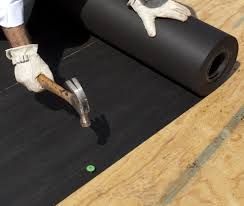
Tarred felt paper, a vital roof underlayment in roofing systems, is widely recognized for its role as an adequate underlayment beneath shingles. This specialized paper, often called felt, is impregnated with tar to enhance its durability and water-resistant properties. When installed on a roof, tarred felt paper is a secondary barrier against moisture, protecting the underlying structure from potential water damage. This underlayment is particularly crucial in areas with significant rainfall or snow, as it provides an additional layer of insulation that extends the roof's longevity.
Stabilizing is a standard practice in the roofing industry due to its cost-effectiveness and ease of installation. Roofers typically roll out the felt paper over the roof deck, securing it with staples or nails before laying down the shingles. The Tarred felt paper installation process ensures that any water that penetrates the shingles is absorbed by the tarred felt paper, preventing it from reaching the roof deck and causing rot or mold growth. By serving as a reliable roof underlayment tarred felt paper not only improves the overall performance of the roofing material but also plays a critical role in maintaining the overall structural integrity of the home in Denver.
In addition to its protective qualities, tarred felt paper plays a significant role in stabilizing the shingles by providing a smooth, even surface for their installation. This stability reduces the likelihood of shingles shifting or lifting due to wind or thermal expansion. Moreover, using tarred felt paper as an underlayment can significantly enhance the roof's aesthetic appeal by ensuring that shingles lay flat and uniformly. This not only improves the overall look of the roof but also makes the property in Denver more visually appealing and something to be proud of.
Felt Near Me
When searching for 'felt near me' in the Denver area, it is essential to understand the significance of roof felt in residential and commercial roofing projects, especially in our unique climate. Roof felt, also known as tar paper, is a critical underlayment that provides an additional layer of insulation and protection between the roof deck and the shingles. In Denver's climate, where we experience significant snowfall and occasional heavy rains, the felt underlayment plays a crucial role in preventing any moisture or water leaking through, which can cause damage to the roof decking and reduce the lifespan of the roof shingles.
By exploring local suppliers for 'felt near me,' homeowners and contractors in the Denver area can ensure access to high-quality materials that meet industry standards, providing security in roofing projects. Roof felt comes in various types and thicknesses; each underlayment roof felt has been engineered and designed to cater to specific roofing problems. It is extremely important that the appropriate felt paper is installed, or it could create serious roof moisture, as it directly impacts the overall durability and performance of the underlayment roofing system. When considering "felt near me," one should evaluate the options available, such as organic felt and synthetic underlayment, which offer unique benefits.
Organic felt is typically made from paper saturated with asphalt, providing a traditional and cost-effective solution. It is known for its ability to absorb moisture and its biodegradability. On the other hand, synthetic roof underlayment, made from polypropylene or polyester, offers superior tear resistance and longevity and is less prone to mold and mildew growth.
Locating reputable suppliers for 'felt near me' can also streamline the installation process by ensuring timely materials delivery and access to expert advice.
Professional roofing contractors rely on these local sources to maintain project efficiency and quality. Whether you are a Denver area homeowner undertaking a DIY project or a Denver roofing contractor managing multiple roofing job sites, having reliable access to roof felt and related products, like underlayment and shingles, is essential for successful roof installation and maintenance. Therefore, conducting thorough research on suppliers' near me' is crucial and will empower you to make the best choices for your roofing project, instilling confidence in your decisions.
Felt Underlayment
Roof underlayment is a crucial component in constructing and maintaining a roofing system. Positioned directly beneath the shingles, this layer is an additional protective barrier against moisture, wind, and other environmental factors. The underlayment felt ensures that any water infiltrating through the shingles will be directed away from the roof deck, thereby preventing potential water damage and extending the lifespan of the roof.
This layer is not just essential, but urgent in areas prone to heavy hail storms, wind, rainfall or snow, where the roof's integrity can be significantly compromised without adequate protection. The importance of this decision should make homeowners and contractors feel the urgency of their choice in selecting the right underlayment.
The choice of underlayment felt material is a important decision that can significantly influence the performance and cost of the roofing repairs and replacement. Traditional felt underlayment, typically made from asphalt-saturated organic or fiberglass substrates, strikes a balance between durability and cost-effectiveness. However, advances in roofing technology have introduced synthetic alternatives that provide superior strength and moisture resistance, albeit at a higher cost.
When selecting the appropriate roof felt underlayment, homeowners and contractors must carefully consider the initial cost against long-term benefits such as enhanced protection and reduced maintenance expenses.
Roof underlayment, beyond its protective functions, plays a pivotal role in the overall stability and performance of the roof. It provides a secondary weatherproofing layer that ensures the roof remains resilient against severe weather conditions.
Furthermore, it cushions the shingles, reducing the risk of abrasion and other mechanical damage. roof felt underlayment is an added layer of protection can contribute to a more uniform and aesthetically pleasing roof appearance. Given its multifaceted benefits, investing in high-quality felt underlayment is a wise decision that can significantly enhance the durability and efficiency of a roofing system, justifying any additional upfront cost involved.
Roofing Felt Tar Paper
Roofing felt tar paper, a protective underlayment, has long been a staple in the roofing industry. Traditionally made from organic materials saturated with tar, this felt type provides a reliable moisture barrier, protecting the roof deck from water infiltration and subsequent damage. However, with the emergence of synthetic underlayment options, which offer superior performance and longevity due to technological advancements, the roofing industry is evolving. In Denver, where weather conditions can be particularly harsh, staying informed about these advancements is crucial for ensuring the resilience and effectiveness of roofing projects.
Synthetic roofing felt offers several advantages over traditional tar felt. It is lighter, more durable, and less susceptible to tears and wear. Additionally, synthetic underlayment can withstand extreme temperatures, making it an excellent choice for the diverse climate conditions experienced in Denver. The installation process is also more straightforward with artificial materials, reducing labor costs and time.
Despite these benefits, traditional tar felt remains popular due to its proven performance and cost-effectiveness. Both options provide robust protection for roofing systems, but the choice between synthetic and tar felt depends on specific project requirements and environmental considerations.
In Denver's competitive roofing market, contractors are faced with the task of choosing between tar felt and synthetic underlayment. This decision should not be taken lightly. It requires a comprehensive assessment of factors such as material performance, cost, and environmental impact. While synthetic options are gaining traction for their enhanced features and sustainability, traditional tar felt continues to hold its ground due to its reliability and affordability.
The ultimate goal is to select an underlayment that offers optimal protection against Denver's unpredictable weather conditions, whether it's synthetic or tar felt. The importance of quality underlayment in maintaining the integrity of roofing systems cannot be overstated.
Roofing felt underlay
Roofing felt underlay plays a crucial role in modern roofing systems, particularly in regions with diverse weather conditions like Denver. It works as a protective barrier, shielding the roof deck from moisture infiltration and providing an additional insulation layer. When undertaking construction or renovation projects in Denver, it's vital to carefully consider the quality and type of roofing felt underlay used. The choice of underlay can significantly influence the longevity and durability of the roofing system. High-quality felt underlay not only enhances the roof's resistance to water but also contributes to its structural integrity.
In Denver, where the climate can vary drastically from season to season, employing a reliable roofing felt underlay is even more crucial. The underlay serves as a secondary defense against the harsh weather conditions typical in this region. It ensures that any water penetrating the primary roofing material does not reach the roof deck, preventing potential damage and costly repairs. More than that, given the importance of sustainable roofing underlay felt selecting a durable and efficient felt underlay on a roof can also contribute to energy efficiency by improving the overall thermal performance of the building, making your construction project more environmentally responsible and forward-thinking.
Roofing contractors and homeowners in Denver increasingly recognize the benefits of high-quality roofing felt underlay. Its role in extending the lifespan of roofing structures cannot be overstated. By investing in superior felt underlay, one not only ensures better protection against environmental elements but also adds value to the property. Whether for new construction or refurbishment projects, opting for top-grade roofing felt underlay is a prudent decision that offers long-term benefits, providing you with the security and confidence in your inves oofing Felt Underlay

Synthetic roofing felt, a superior alternative to traditional tar-based underlayment, offers numerous advantages for both residential and commercial applications. Crafted from high-quality polymers, it provides enhanced durability, moisture resistance, and increased longevity. In Denver's variable climate, these attributes are particularly beneficial, ensuring the underlayment remains intact and effective despite exposure to extreme weather conditions. Its lightweight nature and ease of installation compared to tar-based counterparts also reduce labor costs and installation time.
Synthetic roofing felt provides excellent tear resistance, which is crucial during installation and throughout the lifespan of the roof. Given Denver's susceptibility to high winds, this feature ensures that the underlayment remains secure beneath the shingles, thereby enhancing the overall integrity of the roofing system. Additionally, synthetic underlayment is often designed with slip-resistant surfaces, significantly improving safety for workers during installation and making them feel secure and protected.
Furthermore, synthetic roofing felt is a more environmentally friendly option than traditional tar-based felt. Its production involves fewer harmful chemicals, and it often contains recycled materials, contributing to sustainable building practices.
As building codes and environmental regulations in cities like Denver become increasingly stringent, the shift towards synthetic options is both a practical and responsible choice for contractors and property owners.
With its blend of durability, ease of installation, and environmental benefits, synthetic roofing feels like a significant advancement in modern roofing technology. Whether for new construction or re-roofing projects in Denver or beyond, synthetic underlayment offers an optimal solution that meets the demands of contemporary building standards.
Roofing Felt Synthetic
The newest underlayment felt is Synthetic roofing felt, a game-changer in the roofing industry, offers a robust and efficient alternative to traditional tar paper underlayment. Crafted from top-notch polymers, Synthetic felt boasts unparalleled strength and longevity. This cutting-edge Synthetic felt roof material is gaining traction among roofing contractors and homeowners in Denver, thanks to its remarkable tear resistance, moisture protection, and resilience in harsh weather. Its synthetic composition enables it to function as an exceptional protective barrier, ensuring roofs stay secure and intact, even in the face of severe environmental conditions.
One of the best standout features of synthetic roofing felt is its durability, surpassing its tar-based counterpart. This robustness simplifies the installation process, reducing labor costs and time. Additionally, synthetic felt underlayment is less prone to wrinkling and buckling, which can often compromise the integrity traditional tar felt. In Denver's diverse climate, where temperature fluctuations can be extreme, synthetic roofing felt maintains its structural integrity and continues to protect roofing systems efficiently. The enhanced durability ensures that roofs are better protected against leaks and water damage, contributing to the overall longevity of the structure.
Synthetic roofing felt offers superior UV resistance, which is particularly beneficial in sunny regions like Denver. Traditional tar felt tends to degrade quickly under prolonged sun exposure, whereas synthetic underlayment withstands UV rays effectively, maintaining its protective properties over extended periods. This UV resistance is crucial for preventing premature roof deterioration, saving homeowners from frequent repairs and replacements. The long-term savings from using synthetic roofing felt provide a sense of financial security, offering enhanced protection, durability, and cost-effectiveness compared to traditional tar-based felt underlayment’s.

Felt Roofer In Denver
Denver, where diverse weather conditions demand robust and reliable roofing solutions. Felt, as an underlay material, provides an essential layer of protection beneath the primary roof covering, ensuring longevity and durability. This underlay acts as a barrier against moisture, preventing potential damage from rain, snow, and even wind-driven debris. In Denver, where the climate can oscillate between extremes, the importance of a high-quality felt underlay cannot be overstated.
Roofing professionals in Denver understand that the choice of materials significantly impacts the overall performance and lifespan of a roof. Felt underlay is preferred due to its cost-effectiveness and efficiency in providing an additional protective layer. The installation of felt requires meticulous attention to detail to ensure it functions correctly. A skilled felt roofer will ensure that the felt is laid seamlessly, with no gaps or overlaps that could compromise its integrity.
In the competitive roofing market of Denver, employing a felt roofer who is well-versed with local building codes and standards is indispensable. These professionals are adept at selecting the appropriate type of felt underlay based on specific roofing requirements and environmental factors. By integrating their expertise with high-quality materials, they deliver roofing solutions that stand the test of time. For homeowners and commercial property managers in Denver, investing in a proficient felt roofer assures peace of mind and a well-prote
Felt in Roofing
Felt in roofing is a critical underlay material that enhances the durability and effectiveness of a roof. This underlay, commonly called felt, acts as an additional protective layer between the roofing material and the roof deck. In regions like Denver, where weather conditions can be unpredictable, utilizing felt in roofing becomes indispensable. The felt provides a barrier against moisture keeping the felt water from penetrating the roof deck and causing potential damage. This is particularly important in Denver, where the repairing water damage can be substantial. By incorporating felt as an underlay, homeowners and contractors can ensure that the roofing system remains robust and resilient, providing a sense of security and peace of mind.
The cost of roofing projects can vary significantly depending on the materials used and the complexity of the installation. However, considering its long-term benefits, the relatively modest cost of felt as an underlay is a worthwhile investment. In Denver, where environmental factors such as snow, rain, and high winds are prevalent, the additional expenditure on felt can save homeowners from future repair costs. Moreover, felt underlay adds an extra layer of insulation, which can contribute to energy efficiency by maintaining consistent indoor temperatures. This is another factor that can help mitigate overall costs over time, making you feel financially savvy for choosing felt underlay.
In conclusion, roofing is a vital component that should be carefully considered. Felt, as an underlay, offers numerous advantages, including enhanced protection against moisture, improved insulation, and long-term cost savings. For residents of Denver, investing in felt as an underlay is a prudent decision to ensure their roofing systems' longevity and performance. The significant reduction in potential repair and maintenance expenses justifies the modest initial cost. Therefore, incorporating felt into roofing projects is a practical and economical choice for ensuring durable and reliable roofing solutions.
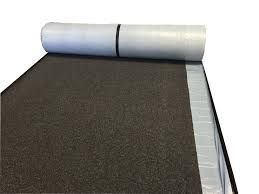
When considering where to get rolled roofing at the best price, rolled roofing from Home Depot and Lowe’s near me emerges as the most practical cost-effective option for residential and commercial applications. Rolled roofing is particularly valued for its affordability and ease of installation, making it an attractive choice for homeowners and business owners. Available at major retailers such as Home Depot and Lowe’s, rolled roofing provides a versatile solution that meets diverse needs.
Whether you are looking to cover a small shed or a large commercial building, these stores offer a variety of rolled roofing materials to suit different budgets and requirements. Rolled roofing, which costs significantly less than traditional shingle or tile roofing, offers substantial savings. This is particularly beneficial for residential projects where budget constraints are often a primary concern.
The ease of installation associated with rolled roofing reduces labor costs, making it an attractive option. For commercial establishments, the durability and low maintenance requirements of rolled roofing ensure long-term value and reliability. Home Depot and Lowe’s offer a wide range of rolled roofing types, catering to the aesthetic and functional demands of different projects.
Moreover, the convenience of having Home Depot and Lowe’s locations near me simplifies the purchasing process, allowing easy access to high-quality roofing materials. These retailers often have knowledgeable staff who can offer expert advice on selecting the correct type of rolled roofing for specific residential or commercial needs. By choosing rolled roofing from Home Depot or Lowe’s, customers can confidently invest in a cost-effective, durable solution that will protect their properties for years.
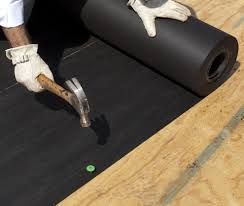
Home Depot and Lowe’s near you are reliable options to consider when searching for high-quality asphalt paper for your roofing projects. Both retailers offer a wide range of asphalt paper products for residential and commercial applications. Asphalt paper, also known as roofing felt, is an essential material in the construction industry. Asphalt paper provides a protective layer between the roof deck and shingles. This layer helps prevent water infiltration, thereby extending the roof's lifespan.
Home Depot has various types of asphalt paper that cater to different needs and budgets. The cost of asphalt paper at Home Depot is competitive, ensuring that you can find an Asphalt paper that meets your roof budget without compromising quality. Similarly, Lowe’s offers a comprehensive selection of asphalt paper products for residential and commercial use. The cost at Lowe’s is also reasonable, making it a viable option for homeowners and contractors.
Whether you are working on a small residential project or a significant commercial development, selecting the right asphalt paper is crucial. The cost of asphalt paper may vary based on the thickness and brand; however, Home Depot and Lowe’s provide detailed product descriptions and many customer reviews to help you make an informed decision. Additionally, both stores often have sales and promotions, which can further reduce costs, making these materials even more affordable.
Home Depot and Lowe’s are leading retailers offering quality products at competitive prices when looking for asphalt paper near you. Their extensive range ensures you can find the perfect asphalt paper for any residential or commercial project while keeping costs in check. Home Depot and Lowe’s near you are reliable options to consider when searching for high-quality asphalt paper for your roofing projects.
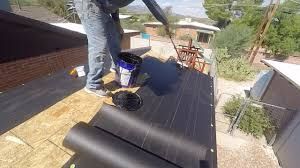
When it comes to reliable roofing materials, tar paper is a popular choice for residential and commercial applications. Home Depot and Lowes, two of the largest home improvement retailers, understand the importance of finding quality tar paper at a reasonable cost. They offer a wide selection of tar paper that meets various needs and budgets. This crucial component, also known as roofing felt, works as a protective layer, shielding the roof decking from water infiltration and other potential damages, helps with the longevity and durability of a roof. Whether you are involved in a residential project or a commercial construction venture, Home Depot and Lowes are committed to helping you find the right tar paper.
Home Depot and Lowes offer a variety of tar paper options to suit specific project needs. For residential projects, they provide lightweight tar paper that is easy to handle and install. On the other hand, commercial projects might require heavier, more durable tar paper. The cost of tar paper at these retailers varies based on factors like thickness, material quality, and brand. However, both Home Depot and Lowes are committed to offering competitive pricing, ensuring that high-quality tar paper is accessible to all customers.
Home Depot and Lowes, in addition to their extensive product range, boast knowledgeable staff who can provide expert guidance on choosing the right tar paper. Home Depot and Lowes roofing materials expertise can help you make informed decisions, ensuring your project's success. Moreover, these stores often run promotional deals and discounts, making high-quality tar paper more affordable. For anyone embarking on a residential or commercial roofing project, a visit to Home Depot or Lowes can be a crucial step in securing the right tar paper at the right price.
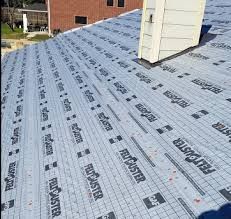
When considering felt paper options, Home Depot and Lowe's offer extensive selections suitable for various residential and commercial applications. Felt paper, often used in roofing and flooring projects, protects against moisture and weather elements. Specifically, Home Depot and Lowe's provide a range of felt paper products that cater to different needs and budgets, ensuring customers can find the right type for their projects. The cost of felt paper at these retailers is not just competitive, but also accessible, making it a viable option for DIY enthusiasts and professional contractors alike.
In residential felt paper is commonly used under shingles or tiles to enhance the durability and longevity of roofing systems. It is an additional barrier, preventing water infiltration and protecting the home's structural integrity. Felt paper is equally essential for commercial projects. It is used in large-scale roofing installations where the quality and reliability of materials can significantly impact the project's overall success. Home Depot and Lowe's stock felt paper meets but exceeds industry standards, ensuring that customers receive high-quality products they can trust.
When evaluating the cost of felt paper at Home Depot and Lowe's, it's crucial to consider the long-term benefits it provides. Investing in premium felt paper can lead to reduced maintenance costs and prolonged lifespan of roofs and floors. Both retailers offer various options that balance cost with performance, enabling customers to make informed decisions based on their specific needs. Whether for residential or commercial use, finding the right felt paper at Home Depot or Lowe's near me ensures that your project is built on a foundation of quality and durability, making it a wise and cost-effective investment in the long run.
ARCHIBEQUE ROOFING CONTRACTORS Near Me, ROOFing Underlayment Tar Paper, Felt Paper, Synthetic Roof Felt For Residential & Commercial Roofing
In Denver's diverse climate, where temperature fluctuations can be extreme, synthetic roofing felt maintains its structural integrity and continues to protect roofing systems efficiently. The enhanced durability ensures that roofs are better protected against leaks and water damage, contributing to the overall longevity of the structure. Archibeque Roofing Denver uses only the finest roofing materials Call Archibeque roofing Denver at 720-375-5601
